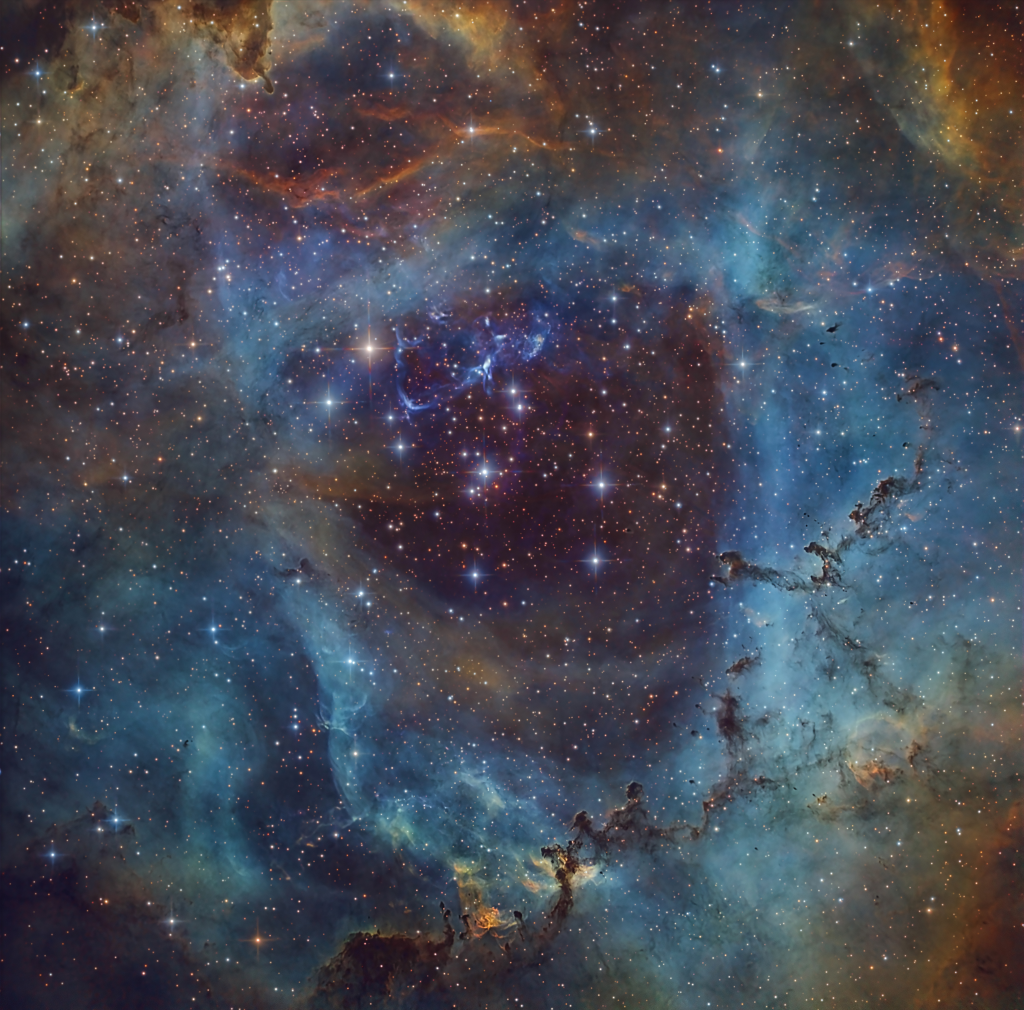09. February 2024
玫瑰若毋是紅色

探索宇宙1!逐工會揀一幅無仝款 ê 影像抑是相片,𤆬你熟似咱這个迷人 ê 宇宙,閣有專業天文學者2為你3解說4。
- 原始文章:When Roses Aren't Red
- 影像來源 kah 版權:Tommy Lease (Denver Astronomical Society)
- 台文翻譯:An-Li Tsai (NSYSU)
[漢羅] 玫瑰若毋是紅色
毋是所有 ê 玫瑰就 一定 是紅色--ê,毋過 in 猶是遐爾媠。 美麗 ê 玫瑰星雲 kah 其他恆星形成區 ê 天文影像,定定攏是紅色--ê,這因為 in ê 色 主要是 ùi 星雲內底 ê 水素原子 發射線來--ê。 水素是上強 ê 可見光發射線,叫做 H-alpha,是光譜內底倚紅光 ê 部份。 毋過發射星雲 無一定愛紅色才會媠。 星雲內底 ê 其他原子,嘛會去予高能恆星光 kā 激發,產生狹頻發射線。 這張玫瑰星雲 ê 特寫影像,是 kā 狹頻影像 用 闊頻色水來表示。 紅色是硫磺原子,青色是水素,藍色是酸素。 實際上,這款 kā 狹頻原子發射線 (SHO) 轉做 闊頻色水 (RGB) ê 方式,定定 tī 哈伯太空望遠鏡 翕 ê 發射星雲影像內底用著。 這張影像是 玫瑰星雲 ê 中央,差不多有 50 光年闊。 這个星雲就 tī 麒麟座方向 3000 光年遠 ê 所在。
[POJ] Mûi-kùi nā-m̄-sī Âng-sek
M̄-sī só͘-ū ê mûi-kùi to̍h it-tēng-sī âng-sek--ê, m̄-koh in iáu-sī hiah-nī súi. Bí-lē ê Mûi-kùi Seng-hûn kah kî-thaⁿ hêng-chheⁿ hêng-sêng-khu ê thian-bûn iáⁿ-siōng, tiāⁿ-tiāⁿ lóng sī âng-sek--ê, che in-ūi in ê sek chú-iàu sī ùi seng-hûn lāi-té ê chúi-sò͘ goân-chú hoat-siā-sòaⁿ lâi--ê. Chúi-sò͘ sī siōng kiông ê khó-kiàn-kng hoat-siā-sòaⁿ, kiò-chò H-alpha, sī kng-phó͘ lāi-té óa âng-kng ê pō͘-hūn. M̄-koh hoat-siā seng-hûn bô-it-tēng ài âng-sek chiah-ē súi. Seng-hûn lāi-té ê kî-thaⁿ goân-chú, mā ē khì hō͘ ko-lêng hêng-chheⁿ-kng kā kek-hoat, sán-seng e̍h-pîn hoat-siā-sòaⁿ. Chit-tiuⁿ Mûi-kùi Seng-hûn ê te̍k-siá iáⁿ-siōng, sī kā e̍h-pîn iáⁿ-siōng iōng khoah-pîn sek-chúi lâi piáu-sī. Âng-sek sī liû-hông goân-chú, chheⁿ-sek sī chúi-sò͘, nâ-sek sī sàng-sò͘. Si̍t-chè-siōng, chit-khoán kā e̍h-pîn goân-chú hoat-siā-sòaⁿ (SHO) choán-chò khoah-pîn sek-chúi (RGB) ê hong-sek, tiāⁿ-tiāⁿ tī Ha-peh Thài-khong Bōng-oán-kiàⁿ hip ê hoat-siā seng-hûn iáⁿ-siōng lāi-té iōng-tio̍h. Chit-tiuⁿ iáⁿ-siōng sī Mûi-kùi Seng-hûn ê tiong-ng, chha-put-to ū 50 kng-nî khoah. Chit-ê seng-hûn to̍h tī Kî-lîn-chō hong-hiòng 3000 kng-nî hn̄g ê só͘-chāi.
[KIP] Muî-kuì nā-m̄-sī Âng-sik
M̄-sī sóo-ū ê muî-kuì to̍h it-tīng-sī âng-sik--ê, m̄-koh in iáu-sī hiah-nī suí. Bí-lē ê Muî-kuì Sing-hûn kah kî-thann hîng-tshenn hîng-sîng-khu ê thian-bûn iánn-siōng, tiānn-tiānn lóng sī âng-sik--ê, tse in-uī in ê sik tsú-iàu sī uì sing-hûn lāi-té ê tsuí-sòo guân-tsú huat-siā-suànn lâi--ê. Tsuí-sòo sī siōng kiông ê khó-kiàn-kng huat-siā-suànn, kiò-tsò H-alpha, sī kng-phóo lāi-té uá âng-kng ê pōo-hūn. M̄-koh huat-siā sing-hûn bô-it-tīng ài âng-sik tsiah-ē suí. Sing-hûn lāi-té ê kî-thann guân-tsú, mā ē khì hōo ko-lîng hîng-tshenn-kng kā kik-huat, sán-sing e̍h-pîn huat-siā-suànn. Tsit-tiunn Muî-kuì Sing-hûn ê ti̍k-siá iánn-siōng, sī kā e̍h-pîn iánn-siōng iōng khuah-pîn sik-tsuí lâi piáu-sī. Âng-sik sī liû-hông guân-tsú, tshenn-sik sī tsuí-sòo, nâ-sik sī sàng-sò͘. Si̍t-tsè-siōng, tsit-khuán kā e̍h-pîn guân-tsú huat-siā-suànn (SHO) tsuán-tsò khuah-pîn sik-tsuí (RGB) ê hong-sik, tiānn-tiānn tī Ha-peh Thài-khong Bōng-uán-kiànn hip ê huat-siā sing-hûn iánn-siōng lāi-té iōng-tio̍h. Tsit-tiunn iánn-siōng sī Muî-kuì Sing-hûn ê tiong-ng, tsha-put-to ū 50 kng-nî khuah. Tsit-ê sing-hûn to̍h tī Kî-lîn-tsō hong-hiòng 3000 kng-nî hn̄g ê sóo-tsāi.
[English] When Roses Aren't Red
Not all roses are red of course, but they can still be very pretty. Likewise, the beautiful Rosette Nebula and other star forming regions are often shown in astronomical images with a predominately red hue, in part because the dominant emission in the nebula is from hydrogen atoms. Hydrogen's strongest optical emission line, known as H-alpha, is in the red region of the spectrum. But the beauty of an emission nebula need not be appreciated in red light alone. Other atoms in the nebula are also excited by energetic starlight and produce narrow emission lines as well. In this close-up view of the Rosette Nebula, narrowband images are mapped into broadband colors to show emission from Sulfur atoms in red, Hydrogen in green, and Oxygen in blue. In fact, the scheme of mapping these narrow atomic emission lines (SHO) into the broader colors (RGB) is adopted in many Hubble images of emission nebulae. This image spans about 50 light-years across the center of the Rosette Nebula. The nebula lies some 3,000 light-years away in the constellation Monoceros.
詞彙學習
| 漢羅 | POJ | KIP | 華語 | English |
|---|---|---|---|---|
| 玫瑰星雲 | Mûi-kùi Seng-hûn | Muî-kuì Sing-hûn | 玫瑰星雲 | Rosette Nebula |
| 恆星形成區 | hêng-chheⁿ hêng-sêng-khu | hîng-tshenn hîng-sîng-khu | 恆星形成區 | star-forming region |
| 可見光 | khó-kiàn-kng | khó-kiàn-kng | 可見光 | optical light |
| 發射線 | hoat-siā-sòaⁿ | huat-siā-suànn | 發射線 | emission line |
| 發射星雲 | hoat-siā seng-hûn | huat-siā sing-hûn | 發射星雲 | emission nebulae |
| 狹頻 | e̍h-pîn | e̍h-pîn | 窄頻 | narrow band |
| 闊頻 | khoah-pîn | khuah-pîn | 寬頻 | broad band |
| 硫磺 | liû-hông | liû-hông | 硫 | sulfur |
| 水素 | chúi-sò͘ | tsuí-sòo | 氫 | hydrogen |
| 酸素 | sàng-sò͘ | sàng-sòo | 氧 | oxygen |
| 麒麟座 | Kî-lîn-chō | Kî-lîn-tsō | 麒麟座 | Monoceros |